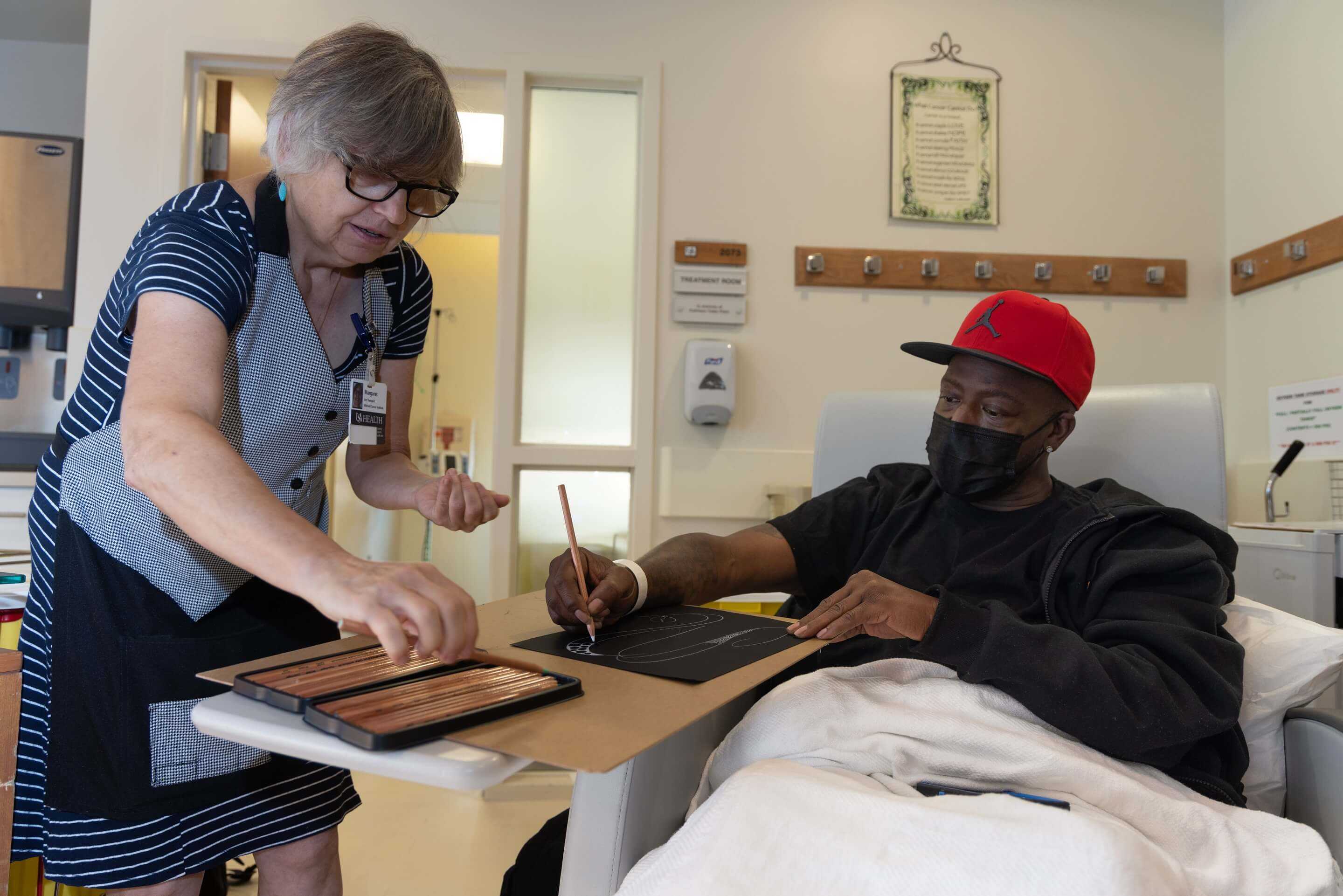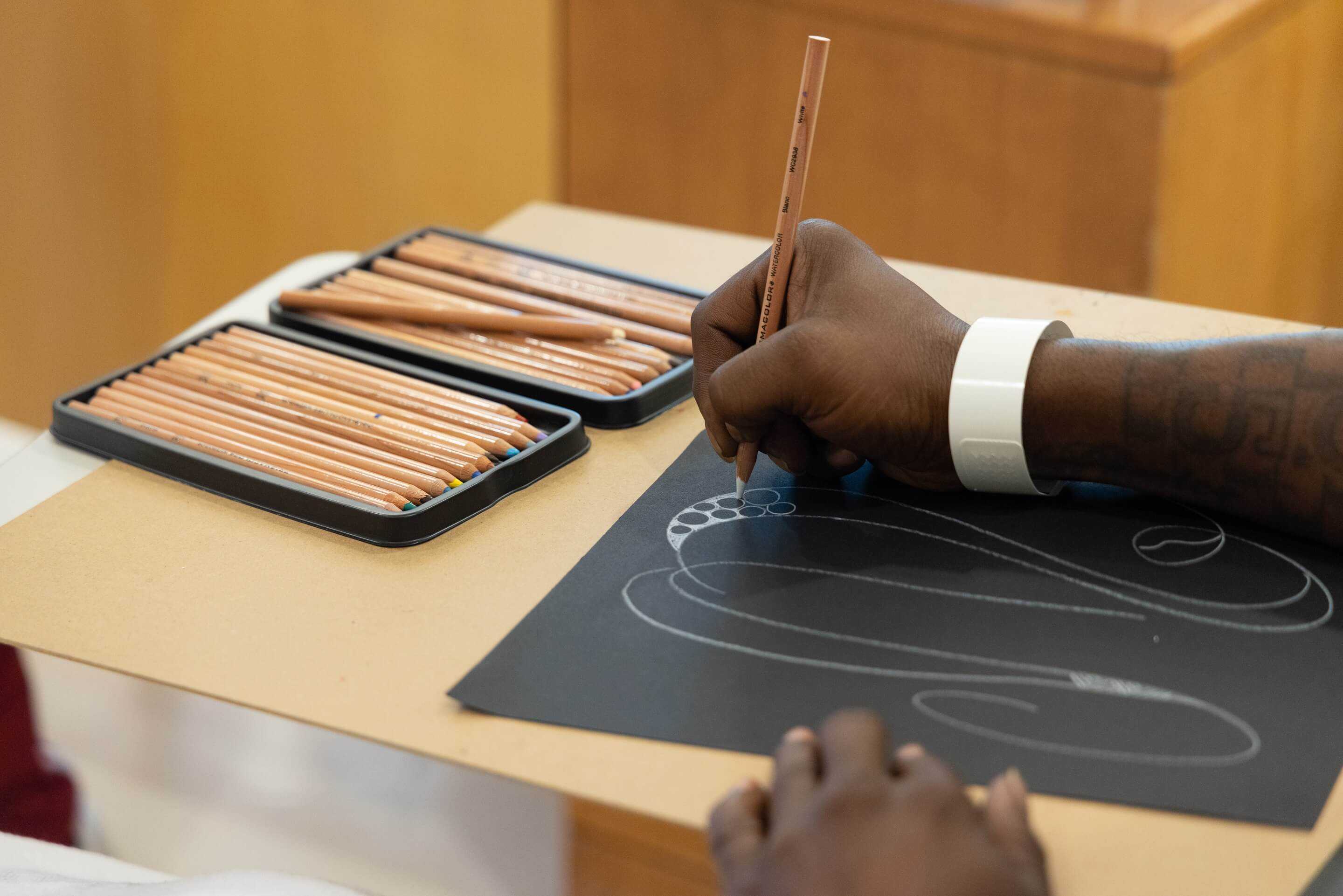
Cancer patients tap into creativity with art therapy during chemotherapy
Art therapist Margaret Wielbut of Fairhope explains that participating in art-related activities satisfies something deep within us. She works with patients in Mobile on Wednesdays, and patients in Fairhope on Tuesdays and Thursdays.
By Carol McPhail
[email protected]

Using a white watercolor pencil, Virginia Ori traces a large circle on a piece of black cardstock. While she waits to start her chemotherapy, the cancer survivor fills in shapes to create a mandala.
“I will probably put a fish in the middle and fill it up with squares, circles and triangles,” said Ori, a French professor who retired from the University of South Alabama. “It’s very relaxing.”
Ori was one of several cancer patients participating in art therapy during their chemo infusions recently at the USA Health Mitchell Cancer Institute.
Art therapist Margaret Wielbut of Fairhope, who guides the patients, explains that participating in art-related activities satisfies something deep within us. “The main goal of art therapy is to help people mentally,” she said.
A systematic review of art therapy in 2018 looked at the effectiveness of the practice for women with breast cancer and found significant benefits. Patients experienced a reduction in anxiety, depression, and fatigue, according to the results published in the Journal of Psychosocial Oncology in 2019.
A native of Poland, Wielbut proposed the idea of art therapy to the Mitchell Cancer Institute after relocating to the Gulf Coast from Michigan, where she worked with children and the elderly. Previously, she studied elementary education at Warsaw University and earned a master’s degree in art therapy from Wayne State University in Detroit.
“Advocating for art therapy and the true knowledge behind developing an art therapist in today’s complicated world has always been my passion,” Wielbut said. “Art can be people’s ‘friend’ only when we are able to find the rich energy behind each mark on the page. An art therapist often needs to unveil the humanness during the entire process, starting from the appropriate choice of the art supplies to the final testimony of the artist.”

After getting a positive reception at the MCI, she connected the cancer institute with the Zoe Foundation, a national nonprofit that funds art programs for cancer patients. The foundation agreed to provide $37,000 in funding.
Wielbut now works with patients on Wednesdays in Mobile, and Tuesdays and Thursdays at the MCI’s Fairhope location. “Without the generosity of the gift, we would not be able to awaken patients’ creative juices, and we would never learn the beauty of communication through art,” she said.
Healthcare providers say art therapy not only helps patients pass the time during their hours-long chemo infusions, but it also gives them something to look forward to. “This has been such a positive thing,” said Lynn Collins, R.N., infusion manager at the MCI. “People are so proud of their work, and we’re proud of them. We didn’t know they had that creativity.”
Once patients get settled in the infusion suite, Wielbut greets them individually to offer art supplies and ideas from her bright yellow rolling cart. Most of the ideas touch on nature. “Some days, everyone will work on the same project, or they may do something different,” she said. “It might be a landscape or creating art from objects found outside.”
Wielbut shows off finished works completed by patients at the MCI. In one project, a patient used twigs and pieces of dyed sheet fabric to create a flowering tree on black paper. Another patient chose an image from a book and recreated it using watercolor pencils.
At the MCI, as Ori continues her mandala in rust, purple, green, and white, Wielbut offers encouragement. “The soft watercolor pencils are giving this an earthy feel,” she said. “It’s almost like when we were going through our early years, playing with sand on the beach.”


